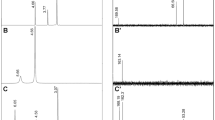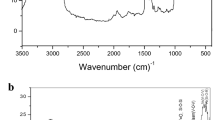Abstract
Combination therapies have been studied by many researchers using different techniques and methods to solve some solid drug problems and improve more effective treatments for humans and animals. One of the more significant findings to emerge from this study is that the combination of pharmaceutical agents by using pharmaceutical deep eutectic solvents (PDESs) in order to produce dual action drugs and reduce the drug resistance. The major objective of this study was to investigate the dual functionality of drugs (antioxidant and antibacterial activity) via the principle of PDESs. The produced PDESs were characterized via different techniques, namely differential scanning calorimetry (DSC), Fourier transform infrared spectroscopy (FTIR), nuclear magnetic resonance (NMR), and UV-Vis spectrophotometry. We herein tested a panel of novel liquid formulations of didecyldimethylammonium bromide (DDMAB) against a selection of pathogenic bacteria, classifying their spectrum of activity against Gram-positive and Gram-negative bacteria. The current study found that the PDESs can be used to produce drugs with dual functionalities. The produced PDES from (ascorbic acid: DDMAB) exhibits stronger antibacterial activity against Gram-positive Staphyloccocus aureus and Staphyloccocus epidermidis than gram negatives. One of the most interesting PDESs studied in this research was that of DDMAB and ascorbic acid. This forms a eutectic which is far from the solid drugs issues and shows dual functionality like antibacterial and antioxidant activity. This study has found that there is a correlation between the molecular docking study and the biological activities of the combined drugs.
Graphical Abstract










Similar content being viewed by others
References
Rahimpour E, Moradi M, Sheikhi-Sovari A, Rezaei H, Rezaei H, Jouyban-Gharamaleki V, et al. Comparative drug solubility studies using shake-flask versus a laser-based robotic method. AAPS PharmSciTech. 2023;24(7):207. https://doi.org/10.1208/s12249-023-02667-9.
Merisko-Liversidge E, Liversidge GG. Nanosizing for oral and parenteral drug delivery: a perspective on formulating poorly-water soluble compounds using wet media milling technology. Adv Drug Deliv Rev. 2011;63(6):427–40. https://doi.org/10.1016/j.addr.2010.12.007.
Santos de Almeida T, Júlio A, Saraiva N, Fernandes AS, Araújo MEM, Baby AR, et al. Choline-versus imidazole-based ionic liquids as functional ingredients in topical delivery systems: cytotoxicity, solubility, and skin permeation studies. Drug Dev Ind Pharm. 2017;43(11):1858–65. https://doi.org/10.1080/03639045.2017.1349788.
Abbott AP, Ahmed EI, Prasad K, Qader IB, Ryder KS. Liquid pharmaceuticals formulation by eutectic formation. Fluid Phase Equilib. 2017;448:2–8. https://doi.org/10.1016/j.fluid.2017.05.009.
Chen Y, Jin X, Kuang Y, Zhang S, Zhang C, Li C, et al. A novel oral drugs delivery system for borneol based on HiCap® 100 and maltodextrin: preparation, characterization, and the investigation as an intestinal absorption enhancer. AAPS PharmSciTech. 2023;24(7):197. https://doi.org/10.1208/s12249-023-02654-0.
Ferraz R, Branco LC, Prudencio C, Noronha JP, Petrovski Ž. Ionic liquids as active pharmaceutical ingredients. ChemMedChem. 2011;6(6):975–85. https://doi.org/10.1002/cmdc.201100082.
Hough WL, Smiglak M, Rodríguez H, Swatloski RP, Spear SK, Daly DT, et al. The third evolution of ionic liquids: active pharmaceutical ingredients. New J Chem. 2007;31(8):1429–36. https://doi.org/10.1039/B706677P.
Qader I. Enhance dissolution rate and solubility of solid drugs through pharmaceutical deep eutectic solvents. ZJPAS. 2021;33:98–106. https://doi.org/10.21271/ZJPAS.33.3.10.
Qader IB, Prasad K. Recent developments on ionic liquids and deep eutectic solvents for drug delivery applications. Pharm Res. 2022;39(10):2367–77. https://doi.org/10.1007/s11095-022-03315-w.
Smith EL, Abbott AP, Ryder KS. Deep eutectic solvents (DESs) and their applications. Chem Rev. 2014;114(21):11060–82. https://doi.org/10.1021/cr300162p.
Kelley SP, Narita A, Holbrey JD, Green KD, Reichert WM, Rogers RD. Understanding the effects of ionicity in salts, solvates, co-crystals, ionic co-crystals, and ionic liquids, rather than nomenclature, is critical to understanding their behavior. Cryst Growth Des. 2013;13(3):965–75. https://doi.org/10.1021/cg4000439.
Qu W, Qader IB, Abbott AP. Controlled release of pharmaceutical agents using eutectic modified gelatin. Drug Deliv Transl Res. 2021;1-8. https://doi.org/10.1007/s13346-021-00998-3.
Qader IB, Kareem JH, Ismail HK, Mahmood HK. Novel phenolic deep eutectic solvents for desulfurisation of petrodiesel. Karbala Int J Mod Sci. 2021;7(12.10):33640. https://doi.org/10.33640/2405-609X.2697.
Abbott AP, Al-Murshedi AY, Alshammari OA, Harris RC, Kareem JH, Qader IB, et al. Thermodynamics of phase transfer for polar molecules from alkanes to deep eutectic solvents. 2017;448:99-104. https://doi.org/10.1016/j.fluid.2017.05.008.
Ismail HK, Qader IB, Alesary HF, Kareem JH, Ballantyne AD. Effect of graphene oxide and temperature on electrochemical polymerization of pyrrole and its stability performance in a novel eutectic solvent (choline chloride–phenol) for supercapacitor applications. ACS Omega. 2022;7(38):34326–40. https://doi.org/10.1021/acssuschemeng.2c06894.
Qader IB, Ismail HK, Alesary HF, Kareem JH, Maaroof YT, Barton S. Electrochemical sensor based on polypyrrole/triiron tetraoxide (PPY/Fe3O4) nanocomposite deposited from a deep eutectic solvent for voltammetric determination of procaine hydrochloride in pharmaceutical formulations. J Electroanal Chem. 2023:117943. https://doi.org/10.1016/j.jelechem.2023.117943.
Sulis G, Sayood S, Gandra S. Antimicrobial resistance in low-and middle-income countries: current status and future directions. Expert Rev Anti-Infect Ther. 2022;20(2):147–60. https://doi.org/10.1080/14787210.2021.1951705.
Arulkumaran N, Routledge M, Schlebusch S, Lipman J, Conway Morris A. Antimicrobial-associated harm in critical care: a narrative review. Intensiv Care Med. 2020;46:225–35. https://doi.org/10.1007/s00134-020-05929-3.
Freitas AR, Werner G. Nosocomial pathogens and antimicrobial resistance: modern challenges and future opportunities. MDPI. 2023;1685. https://doi.org/10.3390/microorganisms11071685.
Sundaramoorthy NS, Shankaran P, Gopalan V, Nagarajan S. New tools to mitigate drug resistance in Enterobacteriaceae-Escherichia coli and Klebsiella pneumoniae. Crit Rev Microbiol. 2023;49(4):435–54. https://doi.org/10.1080/1040841X.2022.2080525.
Medina E, Pieper DH. Tackling threats and future problems of multidrug-resistant bacteria. How to overcome the antibiotic crisis: facts, challenges, technologies and future perspectives. 2016:3-33. https://doi.org/10.1007/82_2016_492.
Dehari D, Chaudhuri A, Kumar DN, Anjum M, Kumar R, Kumar A, et al. A bacteriophage-loaded microparticle laden topical gel for the treatment of multidrug-resistant biofilm-mediated burn wound infection. AAPS PharmSciTech. 2023;24(6):165. https://doi.org/10.1208/s12249-023-02620-w.
Lima PG, Oliveira JT, Amaral JL, Freitas CD, Souza PF. Synthetic antimicrobial peptides: characteristics, design, and potential as alternative molecules to overcome microbial resistance. Life Sci. 2021;278:119647. https://doi.org/10.1016/j.lfs.2021.119647.
Helmy YA, Taha-Abdelaziz K, Hawwas HAE-H, Ghosh S, AlKafaas SS, Moawad MM, et al. Antimicrobial resistance and recent alternatives to antibiotics for the control of bacterial pathogens with an emphasis on foodborne pathogens. Antibiotics. 2023;12(2):274. https://doi.org/10.3390/antibiotics12020274.
Mancuso G, Midiri A, Gerace E, Biondo C. Bacterial antibiotic resistance: the most critical pathogens. Pathogens. 2021;10(10):1310. https://doi.org/10.3390/pathogens10101310.
Römerová S, Dammer O, Zámostný P. Development of an image-based method for tablet microstructure description and its correlation with API release rate. AAPS PharmSciTech. 2023;24(7):199. https://doi.org/10.1208/s12249-023-02658-w.
del Burgo P, Aicart E, Junquera E. Mixed vesicles and mixed micelles of the cationic–cationic surfactant system: didecyldimethylammonium bromide/dodecylethyldimethylammonium bromide/water. Colloids Surf A: Physicochem Eng Asp. 2007;292(2–3):165–72. https://doi.org/10.1016/j.colsurfa.2006.06.019.
Sheraz M, Ahmed S, Ahmad I, Shaikh R, Vaid F, Iqbal K. Formulation and stability of ascorbic acid in topical preparations. Surg Neurol Int. 2011;2(2). https://doi.org/10.4103/0975-8453.86296.
Garcia EJ, Oldoni TLC, Alencar SM, Reis A, Loguercio AD, Grande RHM. Antioxidant activity by DPPH assay of potential solutions to be applied on bleached teeth. Braz Dent J. 2012;23:22–7. https://doi.org/10.1590/S0103-64402012000100004.
De Zoysa MHN, Rathnayake H, Hewawasam RP, Wijayaratne WMDGB. Determination of in vitro antimicrobial activity of five Sri Lankan medicinal plants against selected human pathogenic bacteria. Int J Microbiol. 2019;2019. https://doi.org/10.1155/2019/7431439.
Ganjo AR, Adham AN, Al-Bustany HA, Aka ST. Phytochemical analysis and evaluation of antibacterial activity of extracts against gram-negative bacteria: an and molecular docking studies. Curr Issues Pharm Med Sci. https://doi.org/10.2478/cipms-2022-0035.
Akree LS, Amin ZA, Ahmad HO. In silico and in vivo hepatoprotective activity of the synthesized 5-benzylidene-2-thiohydantoin against diethylnitrosamine-induced liver injury in a rat model. Sci Rep. 2023;13(1):4681. https://doi.org/10.1038/s41598-023-27725-x.
Morris GM, Huey R, Lindstrom W, Sanner MF, Belew RK, Goodsell DS, et al. AutoDock4 and AutoDockTools4: automated docking with selective receptor flexibility. J Comput Chem. 2009;30(16):2785–91. https://doi.org/10.1002/jcc.21256.
Sharef AY, Hamdi BA, Alrawi RA, Ahmad HO. Onopordum acanthium L. extract attenuates pancreatic β-cells and cardiac inflammation in streptozocin-induced diabetic rats. PLoS ONE. 2023;18(1):e0280464. https://doi.org/10.1371/journal.pone.0280464.
Pandey SK, Yadava U, Sharma M, Upadhyay A, Gupt MP, Dwivedi AR, et al. Synthesis, molecular structure investigation, biological evaluation and docking studies of novel spirothiazolidinones. Results Chem. 2023;5:100726. https://doi.org/10.1016/j.rechem.2022.100726.
Adham AN, Sharef AY, Ahmad HO, Abdulla SS. Evaluation of the antioxidant and anti-ulcer activities of the ethanolic extract of Fumaria officinalis. S Afr J Bot. 2022;151:816–25. https://doi.org/10.1016/j.sajb.2022.11.008.
Zhu J, Shao H, Feng L, Lu Y, Meng H, Li C. Absorptive separation of HCl gas by choline chloride-based deep eutectic solvents. J Mol Liq. 2021;341:116928. https://doi.org/10.1016/j.molliq.2021.116928.
Arayachukiat S, Kongtes C, Barthel A, Vummaleti SV, Poater A, Wannakao S, et al. Ascorbic acid as a bifunctional hydrogen bond donor for the synthesis of cyclic carbonates from CO2 under ambient conditions. ACS Sustain Chem Eng. 2017;5(8):6392–7. https://doi.org/10.1021/acssuschemeng.7b01650.
Siddiqui MR, AlOthman ZA, Rahman N. Analytical techniques in pharmaceutical analysis: a review. Arab J Chem. 2017;10:S1409–21. https://doi.org/10.1016/j.arabjc.2013.04.016.
Zheng Q, Zhang Y, Montazerian M, Gulbiten O, Mauro JC, Zanotto ED, et al. Understanding glass through differential scanning calorimetry. Chem Rev. 2019;119(13):7848–939. https://doi.org/10.1021/acs.chemrev.8b00510.
Dimitrova Y. Theoretical study of the changes in the vibrational characteristics arising from the hydrogen bonding between Vitamin C (l-ascorbic acid) and H2O. Spectrochim Acta Part A: Mol Biomol Spectrosc. 2006;63(2):427–37. https://doi.org/10.1016/j.saa.2005.03.037.
Hou Y, Li Z, Ren S, Wu W. Separation of toluene from toluene/alkane mixtures with phosphonium salt based deep eutectic solvents. Fuel Process Technol. 2015;135:99–104. https://doi.org/10.1016/j.fuproc.2014.11.001.
Ribič U, Jakše J, Toplak N, Koren S, Kovač M, Klančnik A, et al. Transporters and efflux pumps are the main mechanisms involved in Staphylococcus epidermidis adaptation and tolerance to Didecyldimethylammonium chloride. Microorganisms. 2020;8(3):344. https://doi.org/10.3390/microorganisms8030344.
Li Y, Wang H, Zheng X, Li Z, Wang M, Luo K, et al. Didecyldimethylammonium bromide: Application to control biofilms of Staphylococcus aureus and Pseudomonas aeruginosa alone and in combination with slightly acidic electrolyzed water. Food Res Int. 2022;157:111236. https://doi.org/10.1016/j.foodres.2022.111236.
Rzemieniecki T, Gwiazdowska D, Rybak K, Materna K, Juś K, Pernak J. Synthesis, properties, and antimicrobial activity of 1-alkyl-4-hydroxy-1-methylpiperidinium ionic liquids with mandelate anion. ACS Sustain Chem Eng. 2019;7(17):15053–63. https://doi.org/10.1016/j.foodres.2022.111236.
Singh TA, Sharma A, Tejwan N, Ghosh N, Das J, Sil PC. A state of the art review on the synthesis, antibacterial, antioxidant, antidiabetic and tissue regeneration activities of zinc oxide nanoparticles. Adv Colloid Interf Sci. 2021;295:102495. https://doi.org/10.1016/j.cis.2021.102495.
Tavares TD, Antunes JC, Padrão J, Ribeiro AI, Zille A, Amorim MTP, et al. Activity of specialized biomolecules against gram-positive and gram-negative bacteria. Antibiotics. 2020;9(6):314. https://doi.org/10.3390/antibiotics9060314.
Ruhal R, Kataria R. Biofilm patterns in gram-positive and gram-negative bacteria. Microbiol Res. 2021;251:126829. https://doi.org/10.1016/j.micres.2021.126829.
Wu X, Yang M, Kim JS, Wang R, Kim G, Ha J, et al. Reactivity differences enable ROS for selective ablation of bacteria. Angew Chem. 2022;134(17):e202200808. https://doi.org/10.1002/ange.202200808.
Si Z, Li J, Ruan L, Reghu S, Ooi YJ, Li P, et al. Designer co-beta-peptide copolymer selectively targets resistant and biofilm Gram-negative bacteria. Biomaterials. 2023;294:122004. https://doi.org/10.1016/j.biomaterials.2023.122004.
Vadillo-Rodríguez V, Cavagnola MA, Pérez-Giraldo C, Fernández-Calderón MC. A physico-chemical study of the interaction of ethanolic extracts of propolis with bacterial cells. Colloids Surf B: Biointerfaces. 2021;200:111571. https://doi.org/10.1016/j.colsurfb.2021.111571.
Brand-Williams W, Cuvelier M-E, Berset C. Use of a free radical method to evaluate antioxidant activity. LWT-Food Sci Technol. 1995;28(1):25–30. https://doi.org/10.1016/S0023-6438(95)80008-5.
Ramzan N, Azeem M, Mahmood K, Shah S, Chughtai FRS, Hanif M, et al. Cellular and non-cellular antioxidant properties of vitamin E–loaded metallic-quercetin/polycaprolactone nanoparticles for the treatment of melanogenesis. AAPS PharmSciTech. 2023;24(6):141. https://doi.org/10.1208/s12249-023-02588-7.
Author information
Authors and Affiliations
Contributions
IBQ: project supervisor, first draft, and corrections. ARG: experimental, corrections, and writing first draft. HOA: writing the draft, experimental, revision, and corrections. HAQ has contributed in terms of literature review and communication. HAH: experimental and revision.
Corresponding author
Ethics declarations
Conflict of Interest
The authors declare no competing interests.
Additional information
Publisher's Note
Springer Nature remains neutral with regard to jurisdictional claims in published maps and institutional affiliations.
Rights and permissions
Springer Nature or its licensor (e.g. a society or other partner) holds exclusive rights to this article under a publishing agreement with the author(s) or other rightsholder(s); author self-archiving of the accepted manuscript version of this article is solely governed by the terms of such publishing agreement and applicable law.
About this article
Cite this article
Qader, I.B., Ganjo, A.R., Ahmad, H.O. et al. Antibacterial and Antioxidant Study of New Pharmaceutical Formulation of Didecyldimethylammonium Bromide Via Pharmaceutical Deep Eutectic Solvents (PDESs) Principle. AAPS PharmSciTech 25, 25 (2024). https://doi.org/10.1208/s12249-024-02739-4
Received:
Accepted:
Published:
DOI: https://doi.org/10.1208/s12249-024-02739-4




